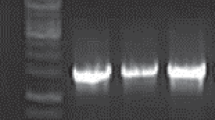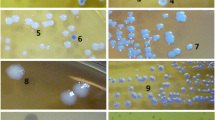Abstract
The DNA base composition and other characteristics of 54 bacterial cultures isolated from refrigerated foods, human clinical specimens, and other sources, designated asP. putrefaciens by one or more investigators were determined.
On the basis of % G + C content and ability to grow in 6.0% NaCl two species were clearly distinguished. The first, consists of 37 isolates all but one incapable of growth in 6.0% NaCl. The DNA composition of these isolates falls within the range of 47.8 to 50.8% G + C with a mean of 49.5 ± 0.7% G + C from Tm determinations. This group contains all fishery and dairy isolates studied, and several isolates from human clinical specimens. The second species consists of 16 isolates, 13 of human clinical origin, 2 from meat products, and 1 from soil. All members of this second species grow readily in 6.0% NaCl and the composition of their DNA falls within the range of 55.9–59.0% G + C with a mean of 57.6 ± 0.65% G + C from Tm determinations.
Similar content being viewed by others
References
Castell, C. H., Richards, J. F. andWilmot, I. 1949.Pseudomonas putrefaciens from cod fillets. - J. Fish. Res. Bd. Can.7: (7) 430.
Chai, T., Chen, C., Rosen, A. andLevin, R. E. 1968. Detection and incidence of specific species of spoilage bacteria on fish. II. Relative incidence ofPseudomonas putrefaciens and fluorescent pseudomonads on haddock fillets. - Appl. Microbiol.16: 1738–1741.
De Ley, J. 1970. Reexamination of the association between melting point, buoyant density, and chemical base composition of deoxyribonucleic acid. - J. Bacteriol.101: 738–754.
Delisle, A. L. andLevin, R. E. 1969. Bacteriophages of psychrophilic pseudomonads. II. Host range of phage active againstPseudomonas putrefaciens. - Antonie van Leeuwenhoek35: 318–324.
Derby, J. A., andHammer, B. W. 1931. Bacteriology of butter. IV. Bacteriological studies on surface taint butter. - Iowa St. Coll. Exp. Sta. Bull.145: 387–416.
Fredericq, E., Oth, A. andFontaine, F. 1961. The ultraviolet spectrum of deoxyribonucleic acids and their constituents. - J. Mol. Biol.3: 11–17.
Gilardi, G. L. 1971. Characterization ofPseudomonas species isolated from clinical specimens. - Appl. Microbiol.21: 414–419.
von Graevenitz, A. andSimon, G. 1970. Potentially pathogenic, non-fermentative, H2S-producing gram-negative rod (1b). - Appl. Microbiol.19: 176.
Hugh, R. 1970. A practical approach to the identification of certain nonfermentative gram-negative rods encountered in clinical specimens. - J. of the Conf. of P. H. Lab. Dir.28: (6) 168–187.
Kovacs, N. 1956. Identification ofPseudomonas pyocyanea by the oxidase reaction. - Nature178: 703.
Levin, R. E. 1968. Detection and incidence of specific species of spoilage bacteria on fish. I. Methodology. - Appl. Microbiol.16: 1734–1737.
Levin, R. E. 1969. Electrically heated cuvette chamber for deoxyribonucleic acid melting point determinations. - Appl. Microbiol.18: 528–530.
Long, H. F. andHammer, B. W. 1941. Distribution ofPseudomonas putrefaciens. - J. Bacteriol.41: 100–101.
Marmur, J. 1961. A procedure for the isolation of deoxyribonucleic acid from micro-organisms. - J. Mol. Biol.3: 208–218.
Marmur, J. andDoty, P. 1962. Determination of the base composition of deoxyribonucleic acid from its thermal denaturation temperature. - J. Mol. Biol.5: 109–118.
Minagawa, M. 1963. Studies on the strains closely related toVibrio parahaemolyticus. - Annu. Rep. Inst. Food Microbiol.16: 9–23.
Olsen, R. H. andMetcalf, E. S. 1968. Conversion of mesophilic to psychrophilic bacteria. - Science162: 1288–1289.
Sadovski, A. Y. andLevin, R. E. 1969. Extracellular nuclease activity of fish spoilage bacteria, fish pathogens, and related species. - Appl. Microbiol.17: 787–789.
Thomas, C. A., Jr., andAbelson, J. 1966. The isolation and characterization of DNA from bacteriophage, p. 553–561.In G. L. Cantoni and D. R. Davies, (ed.), Procedures in nucleic acid research. - Harper and Row, New York.
Author information
Authors and Affiliations
Additional information
This investigation was supported by Public Health Service grant FD 00153-05 from the Food and Drug Administration.
The author wishes to acknowledge helpful correspondence received during the course of this study from G. Gilardi, R. Hugh, M. Mandel, A. von Graevenitz, and R. Weaver.
Rights and permissions
About this article
Cite this article
Levin, R.E. Correlation of DNA base composition and metabolism ofPseudomonas putrefaciens isolates from food, human clinical specimens, and other sources. Antonie van Leeuwenhoek 38, 121–127 (1972). https://doi.org/10.1007/BF02328083
Received:
Issue Date:
DOI: https://doi.org/10.1007/BF02328083




